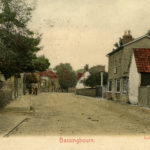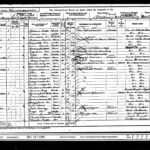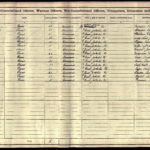Bertie Wiseman, Steeple Morden’s Unknown Warrior?
In St George’s Chapel at Ely Cathedral is the great Cambridgeshire War Memorial, which records parish by parish, the names of all 5230 persons from the County, who lost their lives in World War One. The name B Wiseman is one of those included under Steeple Morden parish. However, this name does not appear on the War Memorial in Steeple Morden Churchyard
Wiseman is not a typical Steeple Morden name, quite the contrary, so who was this B Wiseman and what connection might he have had with Steeple Morden?
After extensive research, which is a story in itself, B Wiseman gradually emerged from the shadows. He is first mentioned, albeit anonymously, as a baby who had been abandoned in extraordinary circumstances. A report in a local newspaper on 3 March 1893 describes how a baby boy about one month old and possibly from London, was abandoned in a public house in Bassingbourn. His young mother ingeniously duped a local youth into wheeling perambulator and baby into the taproom on her behalf, whilst she made good her escape. Her intention was to leave the baby in the care of his putative father and his family, although it became clear that the young father and especially his mother, were having none of it.
More details emerged the following week in a report on 10 March 1893. There was a note attached to the baby signed C Wiseman, who was assumed to be the mother. Apparently, this young lady had been in service at Kneesworth and during this time had kept company with a young man from said public house. After vigorous protestations to the Royston Board of Guardians by the publican’s wife Mrs Wing, on behalf of herself and her son, who denied all knowledge of the child; the baby and his perambulator were accepted into the care of the Royston Workhouse.
Mrs Wing was Harriet, wife of Alfred Wing, baker and publican at The Crown in Bassingbourn High Street and they had two sons. It was her younger son Herbert Preston Wing, she was shielding, who in 1893 was living at Potters Bar. Was he known as Herbert, Bert or perhaps Bertie? Click for the Wing Family and Wing Family Tree.
Baby Wiseman was back in the news a couple of years later, on 23 August 1895, in a newspaper report of the Royston Board of Guardians implementing a national policy of boarding out orphaned children. The Guardians had a Non-Conformist home willing to accept an orphaned child, but Wiseman was in the creed register as Church of England (a toddler already determined to follow a particular faith!). After tortuous discussion between the Guardians, toddler Wiseman’s faith was amended to “uncertain” and with that stroke of a pen, a Non-Conformist foster home awaited him. The location of this new home is not reported, although we do learn his name is Bertie Wiseman.
Mention of Bertie Wiseman has been found in the Steeple Morden School Admission Register. Under Admission No 2435 he started school on 12 March 1900 and his date of birth is given as 22 March 1893? [sic] and his parent as Mrs Morley of North Brook End. His last day at school was 6 April 1906, having reached the school leaving age of 13, as it was in 1906.
Bertie is also to be found in the 1901 Census at Steeple Morden: Bertie Wiseman age 8, birthplace unknown living as a boarder with John and Lucy Morley at North Brook End. John was a carpenter.
It is likely that, on leaving school, Bertie found employment labouring in the building trade or for a local farmer. However, the next official record of him is in the 1911 Census as a Private in the 2nd Battalion, East Yorkshire Regiment serving at Fyzabad, which is near Lucknow in north India, not far from the border with Nepal.
His regimental number 8765 would suggest that he enlisted in December 1907 and elsewhere it is recorded that his place of enlistment was Bury St Edmunds.
At the outbreak of the War, 4 August 1914 Bertie was stationed at Kamptee, a suburb of Nagpur in central India. In December 1914 the 2nd Battalion returned to England, based at Winchester, where they mobilised for war and on 15 January 1915 landed at Havre, France. Bertie was involved in various actions in the Ypres area, with his comrades, although sadly not for long as he was mortally wounded in action and died 6 February 1915.
Bertie’s personal war had lasted exactly three weeks and one day……
His contribution was marked by the posthumous award in 1919/20 of the 1914/15 Star, the British War Medal and the Victory Medal, the three medals known colloquially as Pip, Squeak & Wilfred, after contemporary cartoon characters. One wonders to whom they were sent? His foster mother Lucy Morley?
In the UK Commonwealth War Graves records he is:
Bertie Wiseman, Private 8765 2nd Battalion East Yorkshire Regiment, who died of wounds Saturday 6 February 1915. Born and resident Royston, enlisted Bury St Edmunds. Buried in Hazebrouck Communal Cemetery, France Plot III Row A Grave 30.
At a meeting of the Royston Guardians held 24 March 1915, The Hon Mrs Fordham formally reported that Bertie Wiseman, who was brought to the Workhouse from Bassingbourn 20 years ago, was killed in action February last. Mrs Fordham lived in Steeple Morden and would have known Bertie. Rather touching that the august Guardians should take note of the death of one, who had been in their care.
Yet this Steeple Morden schoolboy, who gave his life for parish and country, is not named on the parish War Memorial.
Bassingbourn The Migrations of a Baby
Transcription of report in Royston Crow 3 March 1893
A good deal of interest and curiosity were occasioned in the village on Tuesday evening last [28 February 1893] by the advent of a baby, and a perambulator, which arrived in the village under peculiar circumstances. It appears that two young women came to Royston by train from London way on Tuesday evening bringing with them a perambulator and a baby. So far there was nothing unusual, but on their arrival at the entrance to the village of Bassingbourn a clever stratagem was resorted to in order for the purpose of bringing the baby into the country. In this instance fortune favoured the fair as well as the brave, and to an unsuspecting young man who happened to be passing home from his daily toil, the young woman in charge of the baby made an off-hand request by asking him if he would mind wheeling the perambulator and the baby into the house of ——–, mentioning a public-house in the village, and tell them that she would be there in a minute after calling at a neighbouring house over the passage to which she could not very well get the perambulator ! In a kind, neighbourly fashion, which did credit to his heart, though it may have gained him no thanks, the young man, without apparently knowing the young ladies who had spoken so fair, wheeled the plump little immigrant right into the tap-room of the public-house with the simple message that he had been asked to leave it there! The occupants of the house were naturally astonished at the consignment, and still more when they found that the little visitor had come in the best of health and spirits, with extra suits of baby clothing and boots and its feeding bottle all complete! Every care seems to have been taken that the little traveller did not suffer any discomfort, but this did not lessen the unfortunate dilemma for the occupants of the house, especially as time passed on without the appearance of anyone to claim the baby. It afterwards transpired that the young women having left the little traveller in good hands made their way back to Royston Station with all speed and departed by the 8 o’clock train, having accomplished their purpose very cleverly and with a success probably beyond their most sanguine expectations! It appears that the adventure, which is understood by many in the village , does not in any way reflect upon the occupants of the house at which the little stranger was left, but that a young man, who formerly lived at the same house, was really the person at whose door the other interested party sought to lay this little responsibility, which we hear would have been handed over for the time being to the Workhouse authorities at Royston pending further inquiries, but up to the time of writing the authorities had refused to receive it.
A Strange Adventure of a Baby
Transcription of a report in Cambridge Independent Press Friday 10 March 1893
At the Board of Guardians on Wednesday, Mrs Wing, the wife of a publican, of Bassingbourn, made an application to the Board under singular circumstances, as to what was to be done with a baby which had been brought to their house. It appears that about a week ago two young women, having a well dressed baby in a perambulator, reached Royston by train, and proceeded towards Bassingbourn. Stopping near some houses at the entrance to the village, they asked a young man who was passing if he would wheel the perambulator and child as far as Mr Wing’s public-house, and take it in and say that they would be there directly. The young man, suspecting nothing wrong, went on with the perambulator and the baby, and wheeled it into the taproom of the public-house, and said he had been told to bring it there by two young women along the road, who would be there directly. The young women, however, never came, but, it appears, turned back immediately they had got rid of the perambulator, and made for Royston, where they caught the last up London train. The baby thus strangely left at the public-house was found to be supplied with extra clothing, feeding bottle, etc. and had a note pinned to its clothing asking that it might be kindly treated for the sake of its father, the note being signed, C. Wiseman. Mrs Wing now explained to the Guardians that the young woman who was believed to be the mother of the child had some two years ago lived in service at Kneesworth, and her (Mrs Wing’s) son kept company with the girl, but her son had been down since this happened and denied that it was his child. At the same time she could not turn the child out until it was provided for, and the Relieving Officer had refused to give an order for it. The Board now consented for the baby, its perambulator, and belongings to be left at the Workhouse, and stated that they must take steps to find the mother.
Meeting of the Royston Board of Guardians 21 August 1895
Transcription of a report in Royston Crow 23 August 1895
Canon Neville laid before the Board the results of the efforts of the Boarding-Out Committee to give effect to the resolution of the Board in favour of boarding out the children in the Workhouse in cottage homes in the villages. Suitable homes and foster parents had been found in the villages for nearly all the available children in the House suitable for boarding out, and he gave the names of children and foster parents. [Discussion particularly around the placing of Roman Catholic children]
Canon Neville called attention to one case in which the child was entered [in the Creed Register] as belonging to the Church of England, and the Committee thought there was evidence that the child, which was a deserted child, was brought in by Nonconformists.
The case referred to was that in which some three years ago a baby a month old was taken by two young women, who had, it is believed, come down by train from London, towards Bassingbourn in a perambulator, and sent it by a messenger to a certain house in the village. The persons at the house disclaimed it and it was brought to the Workhouse, and has remained there ever since.
Mr W S Clear suggested that the persons who brought it attended both Church and chapel.
Mr W W Clear said it seemed to him undesirable to make these distinctions – was it imperative upon the Local Government Board’s order that they must do so?
Mr W S Clear said that he would propose that the Board direct the register to be altered.
Mr E O Fordham said he would second it.
The Rev J G Hale asked upon what evidence.
Mr E O Fordham said the child was brought in by Nonconformists and there was no reason to suppose that the child had any creed. (Laughter).
Mr W A Fordham asked if the people who brought it in were at all anxious upon this point.
Mr Clark said the register in this case was quite as likely to be wrong as right.
Mr W S Clear said he would propose that the entry in the register in respect of this child, Bertie Wiseman, be altered from “Church of England”, to “uncertain”.
Mr Clark seconded this.
Mr T W Russell said he would propose an amendment that it be not altered, but was informed that it was only a negative and he could vote against the proposal.
Mr E O Fordham explained that the Committee had one suitable home which they could provide for a child of this age, and they were unable to so in this case because it was entered on the register as belonging to the Church of England. They inquired into that point and found that the evidence was rather in favour of the child being entered as a Nonconformist than otherwise.
Mr Clark said the reason he seconded this alteration being made was as Mr Fordham had said. It appeared that all they had sanctioned for boarding out were going to Church parents; they had some Nonconformists who were perfectly suitable to take care of the children, but they could not send children to them because they had no Nonconformist children on the creed register. In this case it seemed there was a great deal of doubt and uncertainty whether the child came of Nonconformist or Church parentage; and therefore as it was the only one there was he thought they might very well accept what had been suggested – alter the entry to “uncertain” which would leave the Committee to board out the child where they liked.
The proposal in favour of altering the creed register from “Church of England” to “uncertain”, was then put and carried by 13 against 4.
Killed in Action
Transcription of a report in Cambridge Independent Press 26 March 1915
Meeting of the Royston Board of Guardians held 24 March 1915
The Hon. Mrs Fordham reported that Bertie Wiseman, who was brought to the Workhouse from Bassingbourn 20 years ago, was killed in action February last.
Last Updated on July 5, 2022



